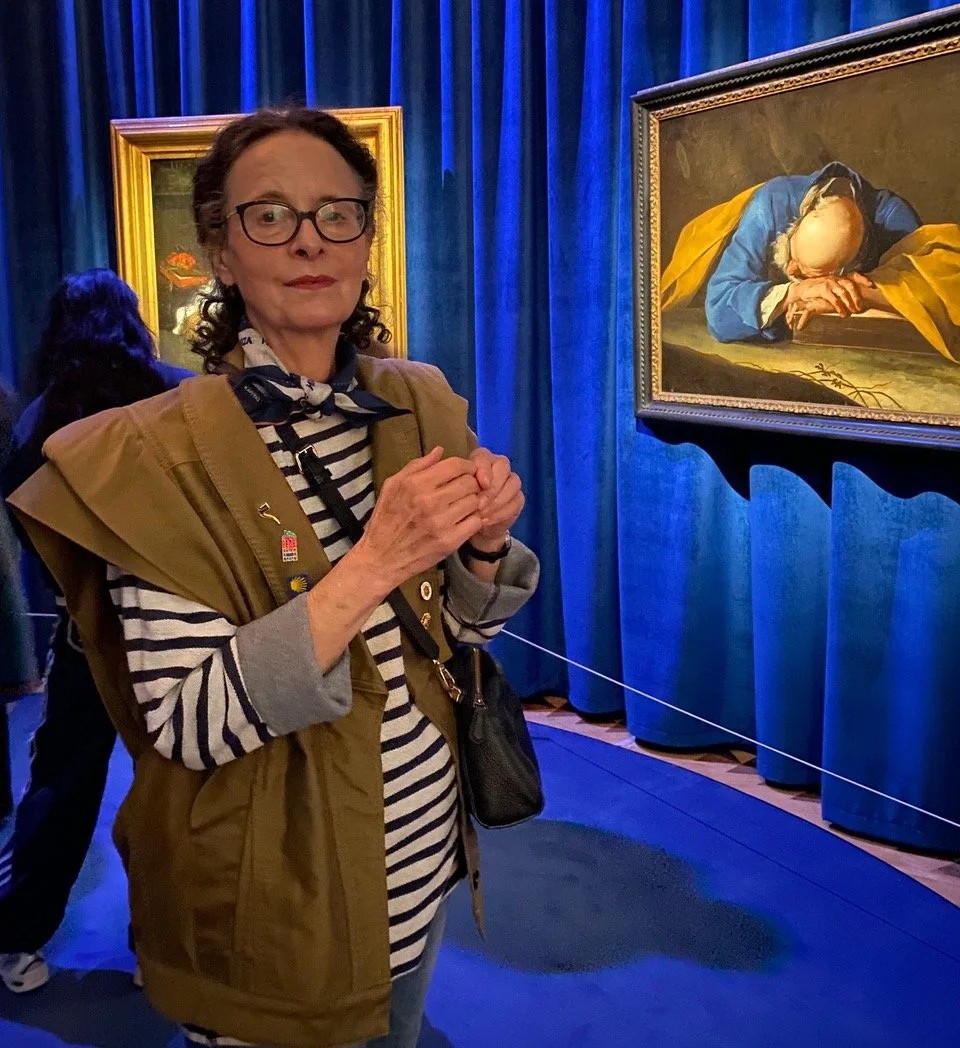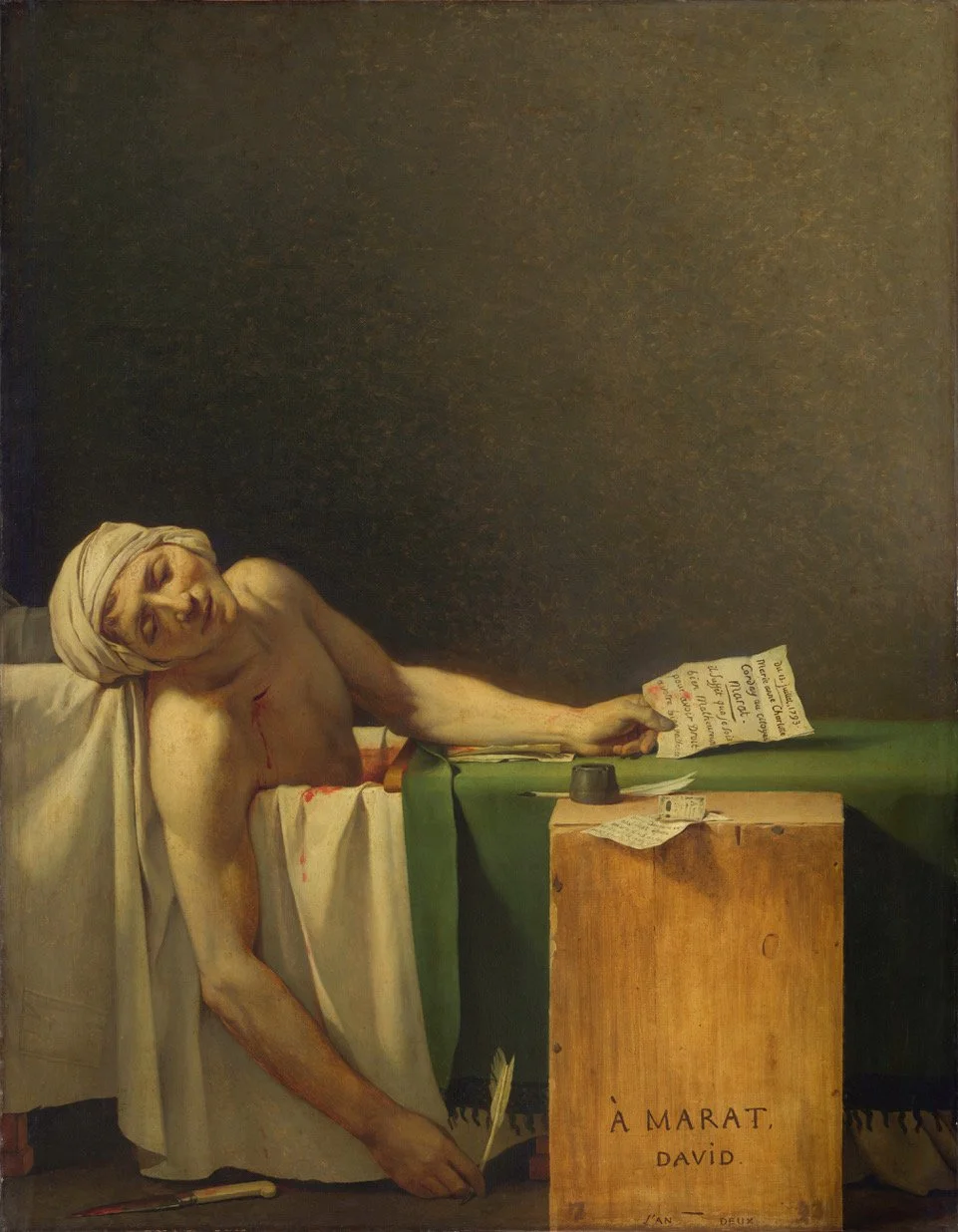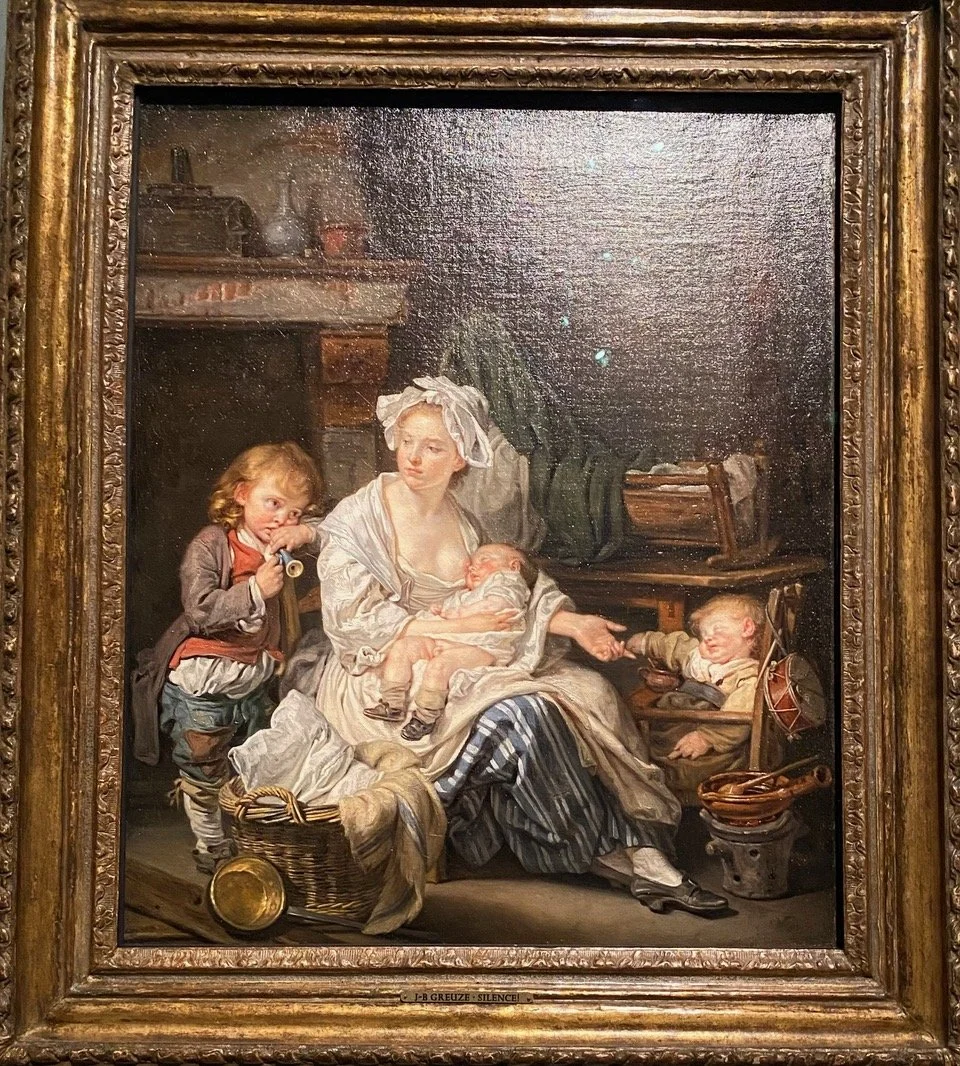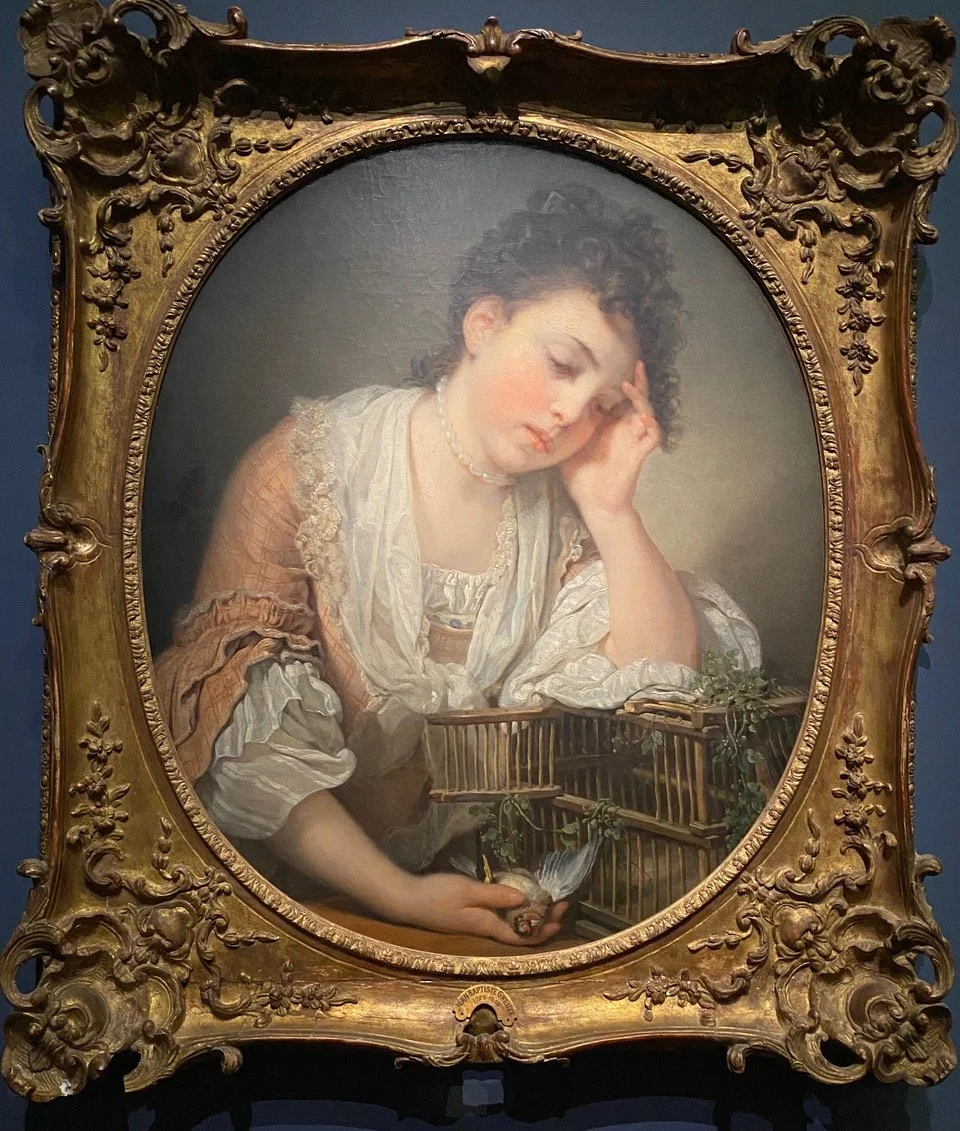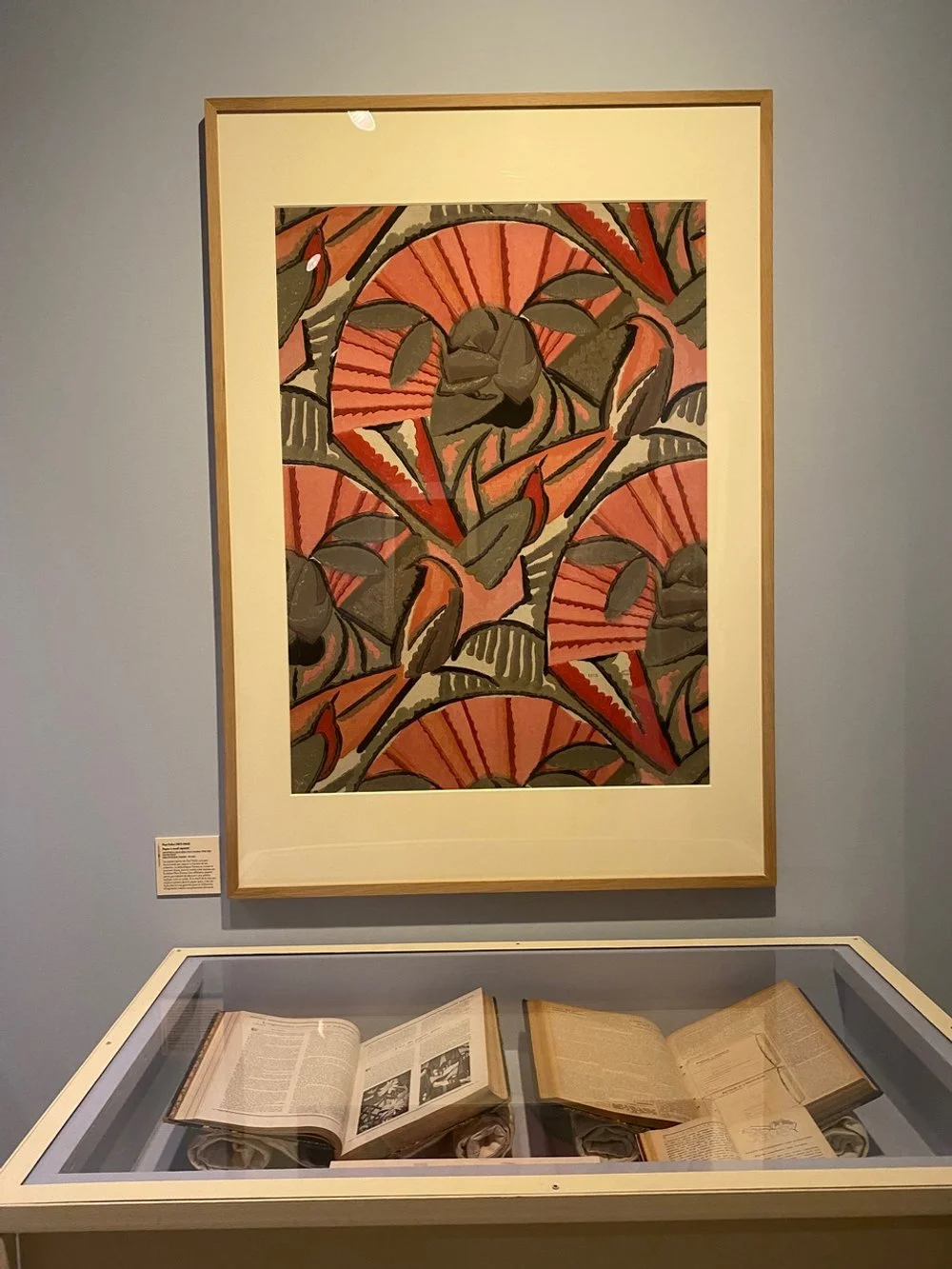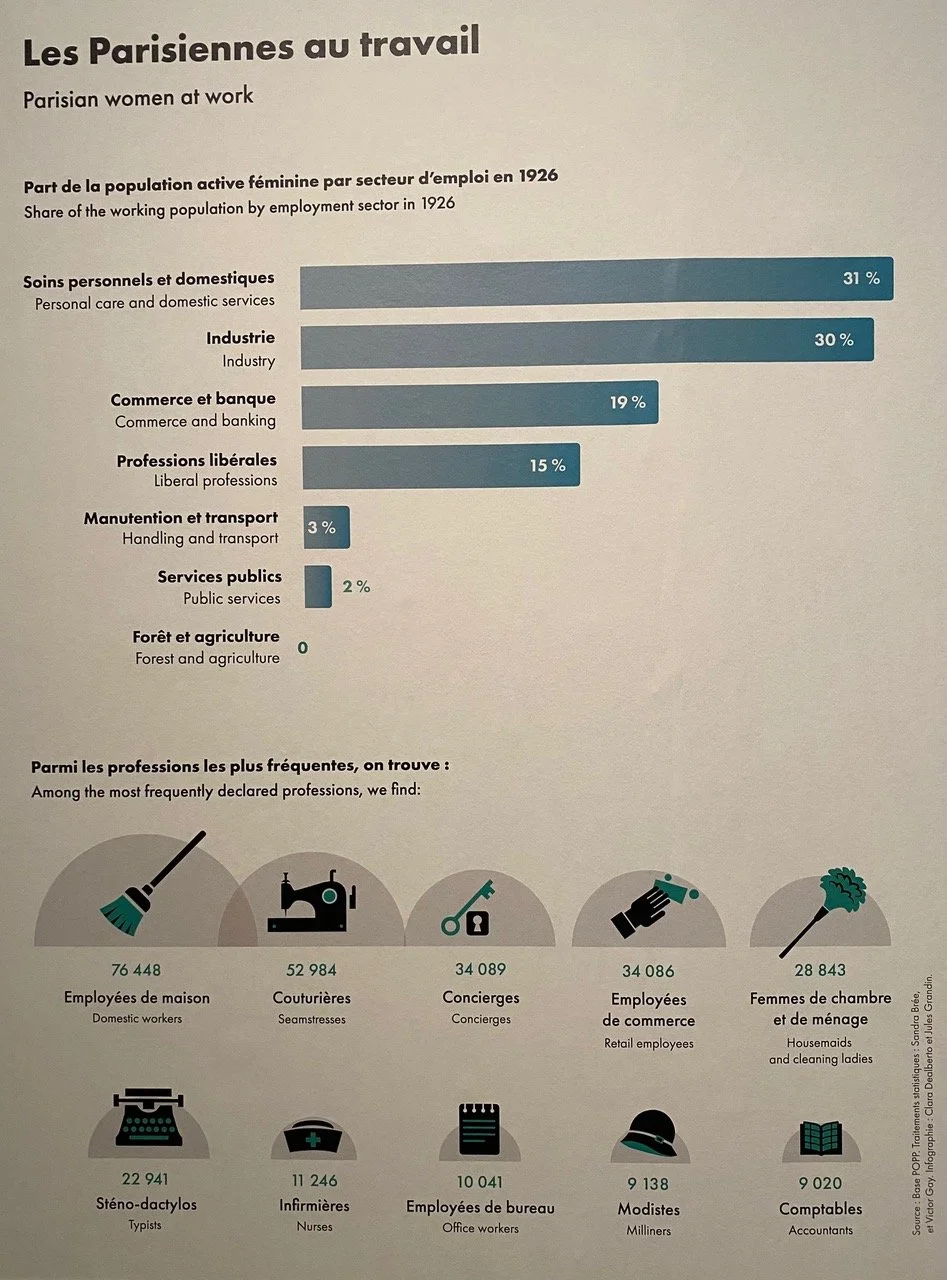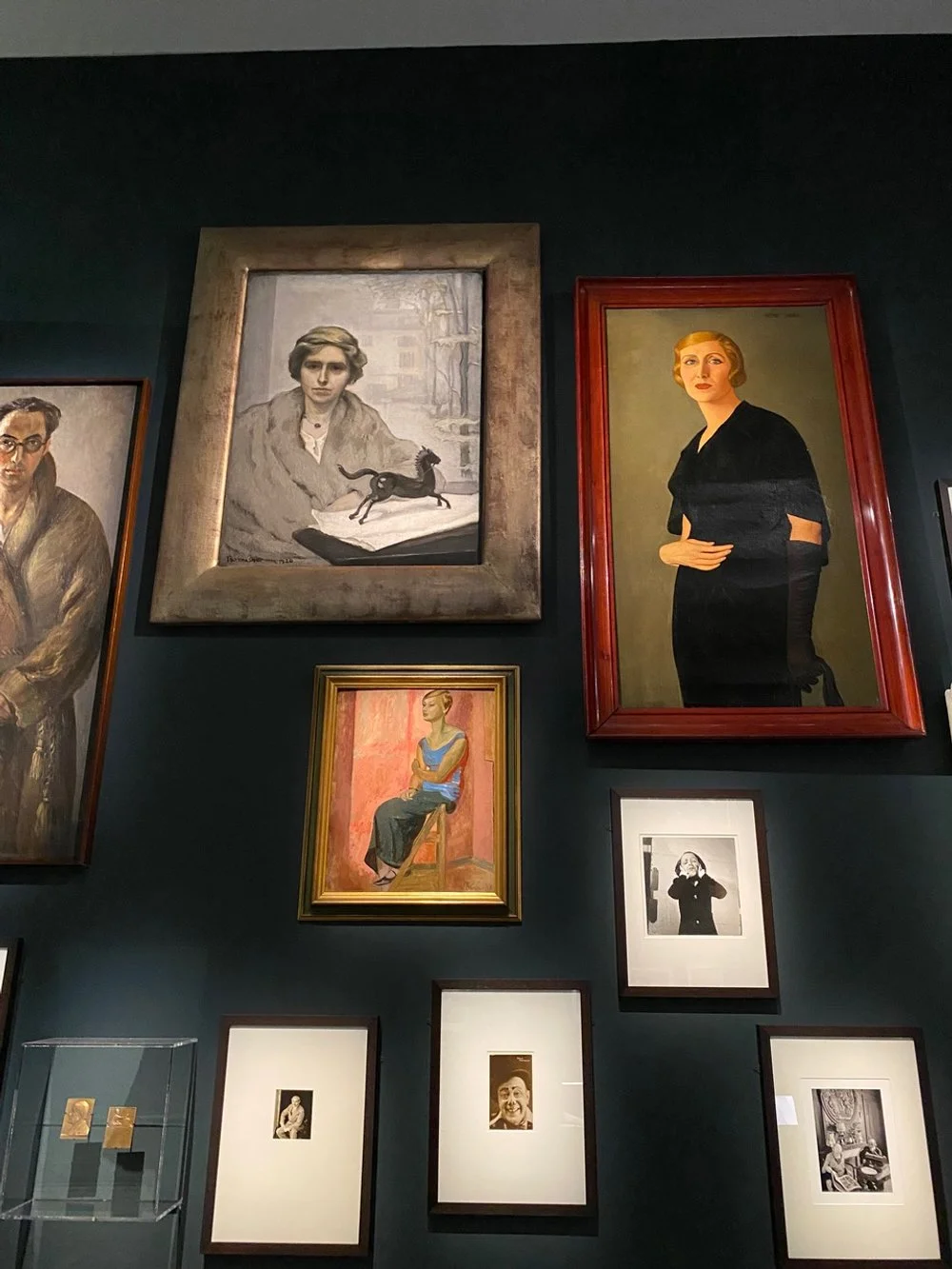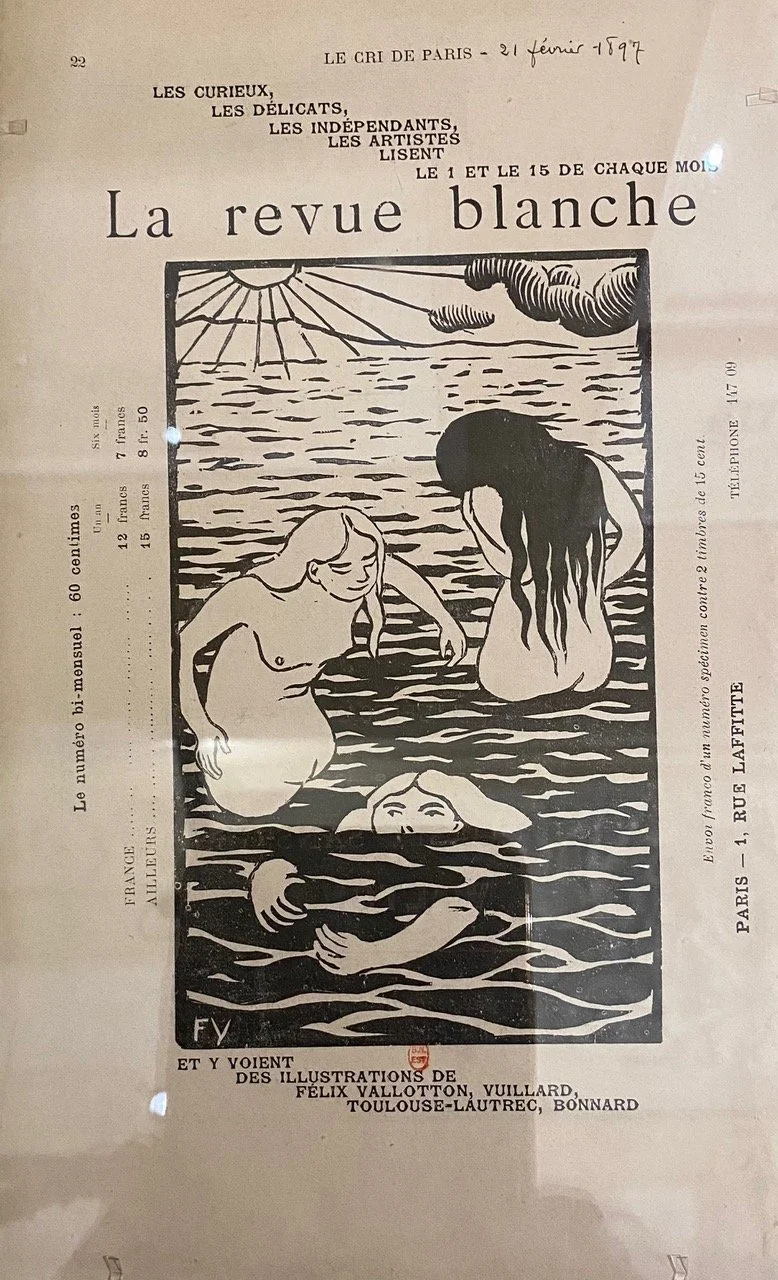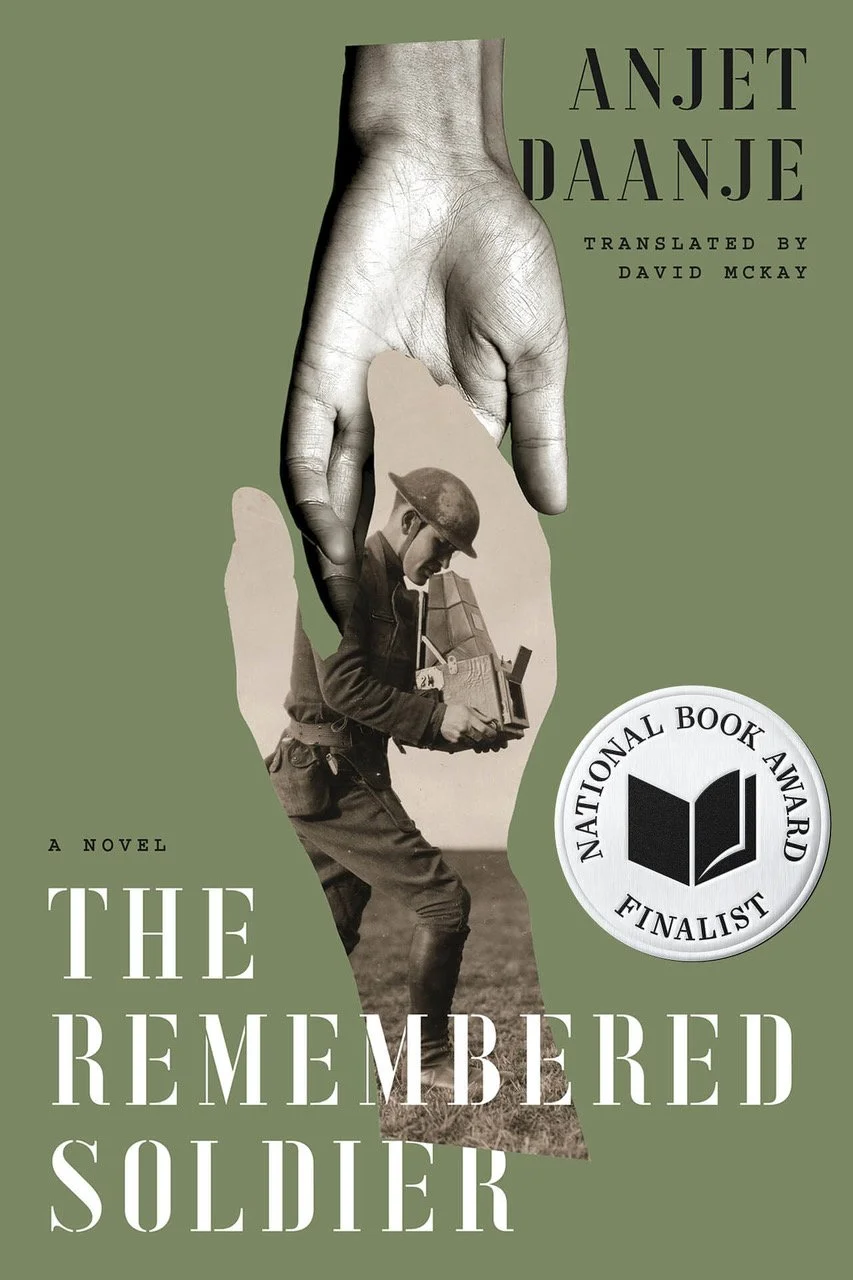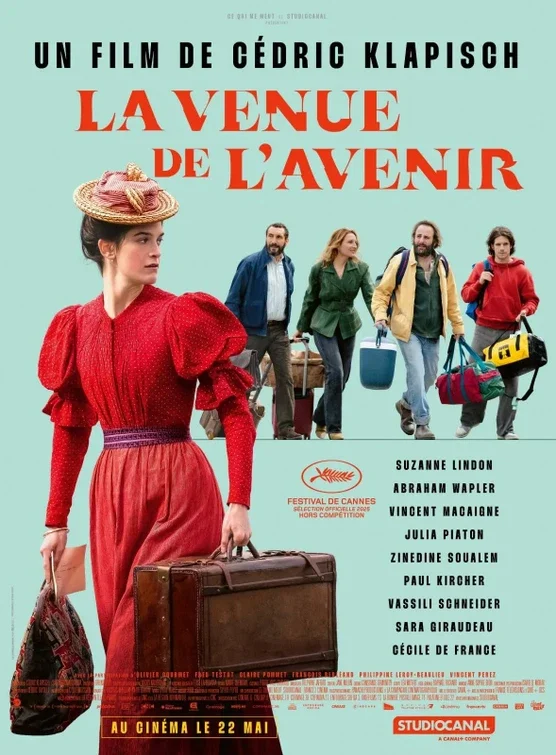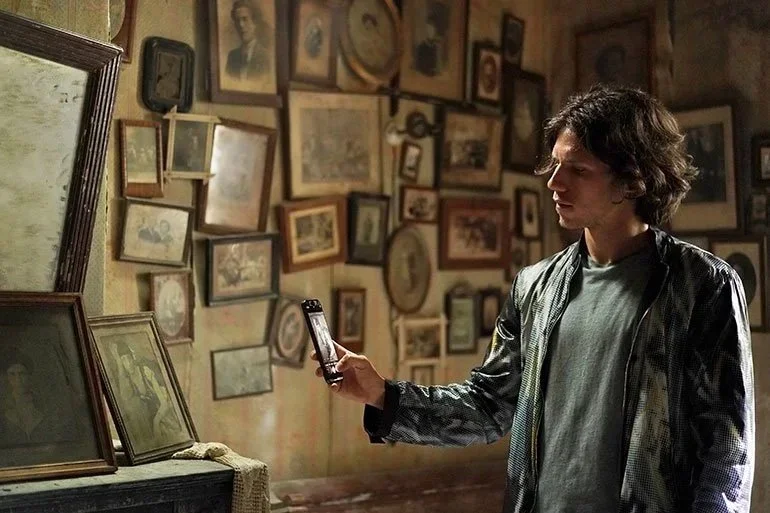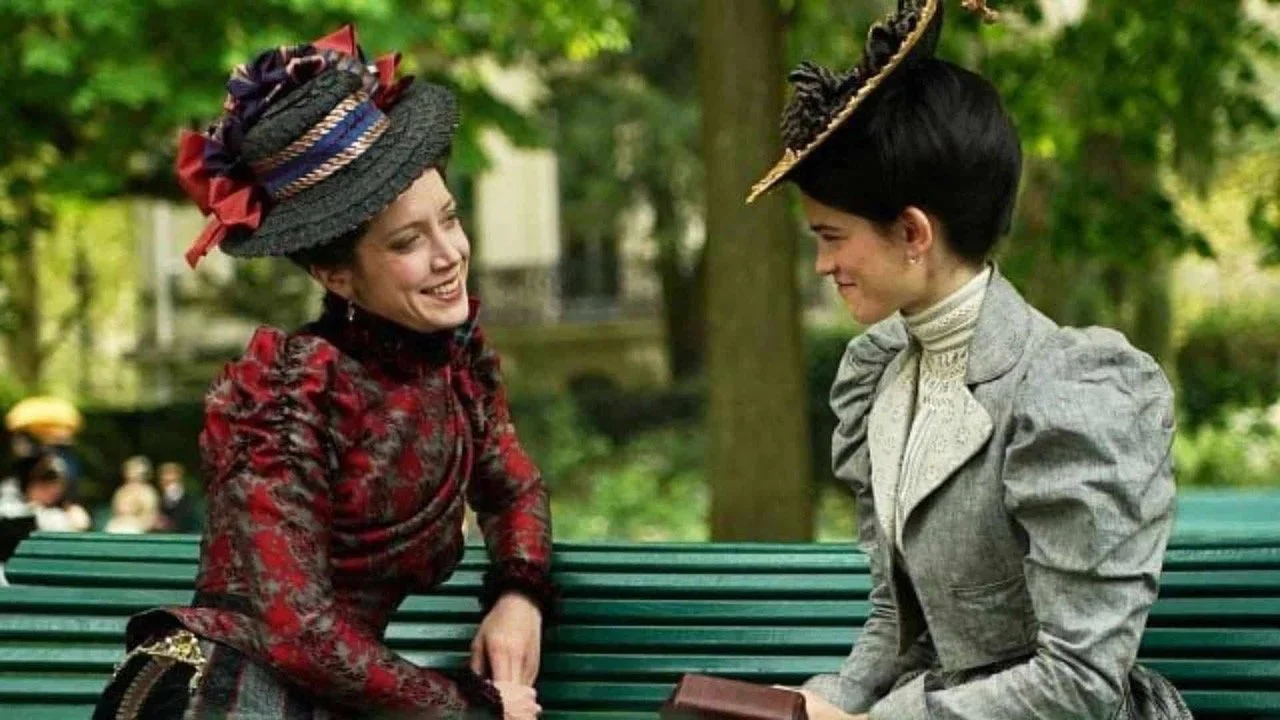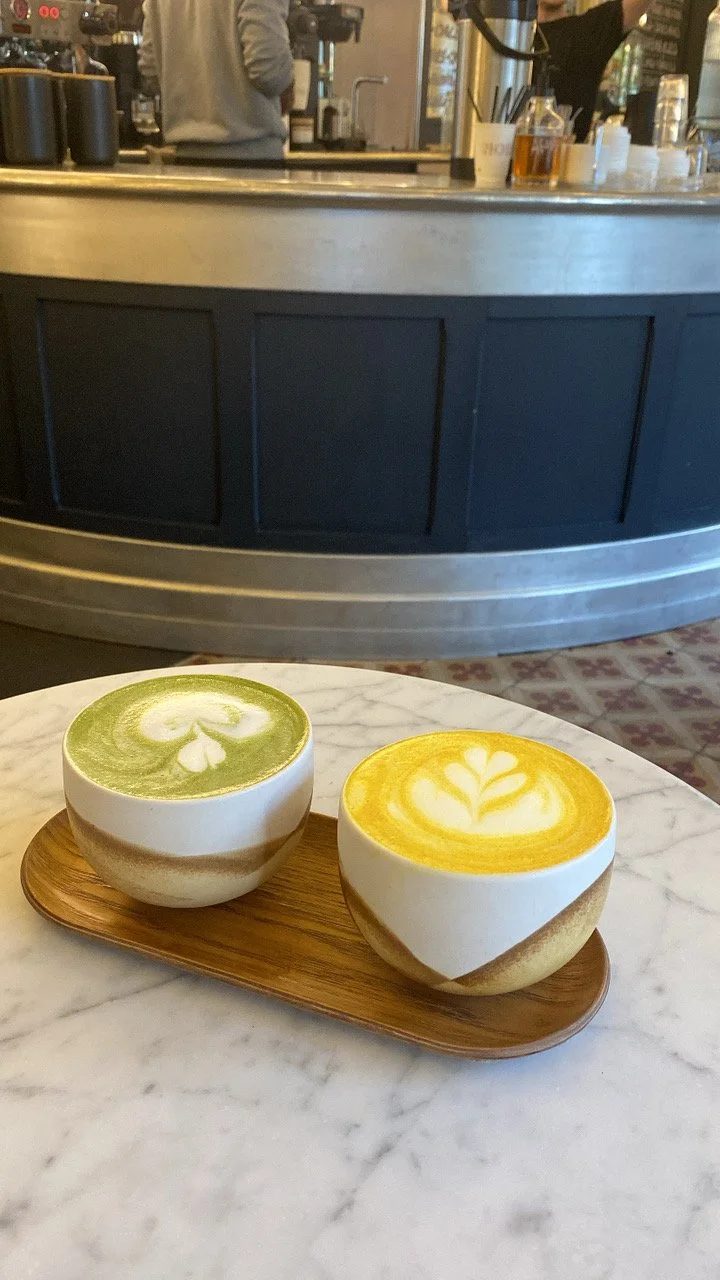Potpourri of Parisian Pleasures
Out and about in Paris
Ginevra walking by a wall near my apartment where Nicolas had been before she arrived
Bienvenue and welcome back to Musée Musings, your idiosyncratic guide to Paris and art. I’m in San Francisco now and looking forward to telling you about the exhibitions I saw just before I left Paris last week. In Paris, I run from exhibition to exhibition and from gallery to gallery. In San Francisco, where there’s more nature than culture, I have more time to think and reflect. Which suits me just fine right now. I need a rest!
The week before I left Paris for San Francisco, two of the exhibitions I saw were about 18th century icons. I finally made it to the Jacques Louis David exhibition that Ginevra and I hadn’t been able to see because the Louvre was closed after the jewelry heist. The exhibit had lots of paintings by David from lots of places but it didn’t have the enormous paintings by David at the Louvre - if you wanted to see those, you had to find them in the museum’s permanent collection. I also saw the Greuze exhibition at the Petit Palais. Although the focus was on Childhood, the curators did a wonderful job depicting Greuze as a three dimensional person and artist and not just an artist who painted young girls with dead birds and/or broken eggs.
The exhibition on Art Deco at the Musée des Arts Decoratifs (MAD) was a disappointment, more an advertisement for the 2025 revamp of the Orient Express than a serious exhibition about the 1925 International Exhibition of Modern Decorative and Industrial Arts in Paris. The exhibition on Art Deco at the Bibliotheque Forney was much better. Its focus was the designers and decorators who created the window displays and advertisements for the four major Parisian department stores in 1925 and who participated in the Fair: Printemps, Bon Marché, Galeries Lafayette and the Grands Magasins du Louvre (which has just reopened, completely restored and renovated by French architect-superstar, Jean Nouvel for the Cartier Foundation for Contemporary Art).
The day I saw the exhibition at the Bibliotheque Forney, I also saw the exhibition at the Musée Carnavalet entitled “Parisians, 1926-1936”. Taking three census reports from 1926, 1931 and 1936, the curators created an exhibition that was visually rich and culturally fascinating. I’ll tell you about it soon. After the Carnavalet, I dashed home for lunch and then rushed over to the Musée de la Chasse et Nature to see an exhibition on unicorns. I arrived the same moment that 50 high school students did. I made a split second decision and determined that I would come back in January. A bit lost for what to do, I remembered the exhibition at the National Archives on Victor Hugo. It was actually an exhibition about his will and funeral. Short but interesting. It was only 3:00 p.m. which meant thatI I had just enough time to see the exhibition at the Bibliotheque Forney. As I went from museum to museum, all of which are no more than a 30 minute walk from my apartment - as are another 5, and that’s not counting the multitude of galleries of mostly contemporary art - I had to pinch myself for my good luck. To be alive in Paris. (F 1-8)
Figure 1. Death of Marat, Jacques Louis David, 1793, Royal Museum of Fine Arts, Brussels
Figure 2. Coronation of Napoleon, Jacques Louis David, 1805-07, Louvre
Figure 3. Mother with Children, Jean-Baptiste Greuze
Figure 4. Young Girl and Dead Bird, Jean-Baptiste Greuze
Figure 5. Department Store brochure, 1925, Bibliotheque de Forney
Figure 6. Art Deco pattern and pattern books, Bibliotheque Forney
Figure 7. The jobs that women held in Paris, 1926, Musée Carnavalet
Figure 8. The marital status of people in Paris from 1926-1936, Musée Carnavalet
My visit to the Forney whetted my appetite for library exhibitions. So, three days before I left for San Francisco, I walked over to the Bibliotheque National de France (BnF) Mitterrand to see a wonderful exhibition on Colette, Les Mondes de Colette. Like the Proust exhibition there a few years ago, this exhibition was filled with manuscripts (of course) but also paintings and photographs and films and ‘things’ (objets) that were important to Colette. And if you are wondering, yes Colette knew Proust. I can’t wait to explore that relationship and report back to you. While I was browsing through the BnF quarterly publication, I noted that there was an exhibition on the Nabis at the gorgeous BnF Richelieu. Called Nabis Impressions, the exhibition features nearly 200 lithographs and engravings by Bonnard, Vuillard, Denis and Vallotton. (Figs 9-13)
Figure 9. Some of the people who lived in Paris, 1920s-1930s, Musée Carnavalet
Figure 10. The Worlds of Colette, Bibliotheque National de France
Figure 11. Colette by Jacques-Émile Blanche
Figure 12. La Famille, Maurice Denis, Bibliotheque National de France Vivienne
Figure 13. La Revue Blanche filled with illustrations by Valloton, Vuillard, Toulouse-Lautrec, Bonnard, BNF Vivienne
14. Ginevra finds a sofa that matches her cell phone case!
I was tempted to see one (or maybe two) exhibitions the penultimate day before my departure, but I resisted the urge. Instead, between packing and cleaning, I ran over to Merci to get Ginevra a bright pink napkin that matched the sofa she had fallen in love with there. (Fig 14) On the way back to my apartment, I went to Moon Croissant on Boulevard Beaumarchais, to fulfill another of Ginevra’s requests. To bring her a croissant from Paris. Moon Croissant is more expensive than the places I usually go (Brigat, MieMie, Utopie) but their croissants are big and gorgeous and I guess the best word to describe them is luxurious. (Figs 15, 16) And yet their prices are lower than those in San Francisco where you get less, so much less for your money. Alas, I arrived too late, they were out of croissants. So I bought a pain au chocolat and the Breton treat, kouign amann. As I was telling the sales person how disappointed my daughter would be, she suggested that I come back the next morning and buy a croissant. When I told her that I was getting picked up at 6:30 a.m. she said that was not a problem, the boulangers start working at 4:00 a.m. and the croissants are ready by 5:00 a.m. I thanked her profusely but declined her gracious offer.
Figure 15. Big, beautiful croissant from Moon Croissant, Blvd Beaumarchais, Paris
Figure 16. Moon Croissant facade, Blvd Beaumarchais
When all the museums are closed and when I’m not taste testing baguettes and brioches, you can usually find me reading. I have just finished a book called The Remembered Soldier, written by Anjet Daanje and beautifully translated into English from the original Dutch by David McKay. (Fig 17) I was expecting the book to have a Retour de Martin Guerre vibe (I’m sure you remember the film based on the book starring Gerard Depardeau). There was a bit of that here. But there was so much more. It took me a while to read and not only because it is nearly 600 pages long. You know there are books, even long books, that you plow through, that you skim. This book is not one of those. This book is like a fine wine, meant to be sipped and savored. Well, I don’t have that much experience with fine wines, but I do know my way around 85% dark chocolate. That I let melt on my tongue as I savor its unctuous richness and identify the myriad flavor notes. And that’s how I read this book, slowly, luxuriating in its rich prose.
Figure 17. The Remembered Soldier, written by Anjet Daanje, translated into English by David McKay
The place, Flanders, the year, 1922. The narrative follows a man suffering from amnesia who had been found four years earlier, at the end of the Great War, (the war to end all wars) wandering around the fields of Flanders. When we meet him, he is living in a psychiatric asylum run by monks. His name, "Noon Merckem” refers to when and where he was found - at 12 noon, in the fields of Merckem. Periodically, the brothers put notes in various local newspapers describing patients who have lost their memories in hopes that their families will read the notes and recognize their loved ones. Which is what happens for Noon. A woman named Julienne comes to the asylum and identifies Noon as her husband, Amand Coppens.
Against the advice of the doctors, Julienne takes Noon home. The book is like a 1000 piece jigsaw puzzle with no picture on the front to help you place the pieces, with only the borders offering any idea of how everything might fit together. Like Amand, aka Noon, we aren’t sure we can trust Julienne. Like him, we must search for clues in his nightmares/dreams/flashbacks. I have just finished reading this beautiful book and I am sorely missing the characters and wondering how they are getting on. More on this soon.
I left Paris for San Francisco three weeks after Ginevra did. When Ginevra and I went to the airport for her flight, the same flight I took, we left at 7:30 for the 10:30 flight. It took an hour to get to the airport and once at the airport, another 30 minutes to get to Terminal 2. Everything is self service, from printing your boarding pass to printing your luggage tags, to putting your luggage on the conveyor belt. By the time Ginevra got through passport control and security and took the tram to her gate, her flight was boarding. That’s too much rushing for me before a 12 hour flight. I left for the airport at 6:30, got there at 7:00 and was sitting at my gate 2 1/2 hours early. Boring, yes, but calm!
I had toyed with the idea of upgrading from economy to business. I won’t bore you with the price of that upgrade. But it wasn’t possible. There were no seats left in business. But there was a surprise in store for me when I boarded the plane. The economy section was empty! Anyone who wanted an entire row to themselves, had an entire row to themselves. Since the arm rests in economy flip up, I flipped them up. And for the first four hours of the flight, comfortably spread out across four seats, I slept.
For the next four hours I watched the same film, twice. First I watched it in French and then I watched it in French with English subtitles. The first time I got the general gist of the film. The second time, I got a better sense of the nuances. And since the film was such a delight visually, seeing it twice was a pleasure. The film wasn’t just any film, it was one that I had been wanting to see ever since I heard the director and cast members interviewed on the one television show I watch in Paris, Quotidien.
As the opening credits roll, we are at the Musée de l’Orangerie with the monumental murals Monet painted of Giverny. A young man is taking photos of a young woman as she strikes a variety of poses. As the two of them, joined by a older woman, look over the photos, he says that he can modify the color of her dress to make it more harmonious with the Monets. Both women tell him that’s impossible, the shoot is a collaboration, the dress is the point of the shoot. He will simply have to change the colors of Monet’s murals! Seriously?!
The premise of this film, called Le Venue de l’Avenir, is this: a group of 30 people, all cousins, mostly distant, have inherited a farmhouse and the land surrounding it in rural Normandy, near Le Havre. We meet them when most of them meet each other, in a conference room in Paris, where most of them live. A woman is explaining their family tree, explaining that they are descendants of one woman’s three children. With French inheritance law being as cumbersome as it is, all of them have to agree about what to do with this inheritance before anything can be done with it. The mayor of the village where the property is located wants the descendants to sell the property to a company that will demolish the house and build a parking lot. It reminded me of the lyrics of Joni Mitchell’s song, "They paved paradise and put up a parking lot".
Soon after the meeting, the group gathers again for a zoom call. As they are talking about what to do, one of the older participants morphs into a cat. The young man who we first saw taking photos at the Orangerie keeps telling him that he is appearing as his Avatar. And keeps explaining what to press on his computer for his face to reappear. It’s a funny and telling detail. The older generation of descendants are mostly ‘null’ when it comes to technology and the younger generation has to patiently keep them on track.
The group decides that four of them should represent all of them and visit the farmhouse. The four include the young photographer, a woman in her 40s who is some sort of engineer, a man, probably a little older than she is, who is a bee-keeper and a man who is just about to retire as a teacher at a lycee. He’s definitely 62, the age French civil servants retire. We see them on the train to Normandy and each one definitely represents a ‘type.’ The young man passes his time looking at Instagram, the woman, stressed out, furiously taps messages on her cell phone. The bee-keeper contentedly looks out at the scenery. The teacher happily talks to the bee-keeper and the other two when they can drag themselves away from their screens.
After battling overgrown grasses to get to the front door of the farmhouse, an official with a bolt cutter opens the door. One wall densely filled with photographs.Two are by the (now) famous photographer, Nadar, of women who must surely be mother and daughter. Another photo shows one of these women, seated, with a baby on her lap and two children at her side. The camera pans over the photo but stops at the shoulders of the man behind her. We can’t see the face of her husband, their father. It’s a neat trick since finding out who this woman marries is integral to the plot of the film.
As they poke around the house, the teacher notices a calendar on which dates are all crossed off - up to 4 September 1944. He explains that whoever stopped marking the dates probably died when Le Havre was bombed by the British on September 5 and 6, 1944. That was when the house was probably last inhabited. Why nobody went back after the war, or even seems to have known about the house after the war, is never explained.
Part of the fun of the film is that it switches back and forth from the present (2024/25) to the past (1895). Why 1895? Because that year, following the death of her grandmother, their ancestor and the owner of this house, the then 20 year old Adèle Munier, sets off for Paris. To find the mother she did not know, the mother she never met.
Adèle meets her mother and learns the probable identity of her father. At one moment we go further back in time and we are with Adèle’s mother and Monet as he paints Impressions Sunrise from their hotel room window in Le Havre. Twenty three years later, we travel with Adèle to meet Monet at Giverny.
There are many wonderful sequences when the two worlds almost collide. For example, at one moment we are running up a steep outdoor stairway in Montmartre with Adèle and her friends and the next minute we are at the top of those stairs with the four contemporary cousins. At one moment we are at an art exhibition where a critic is denouncing Monet’s Impression Sunrise and at another we are at the Museum of Modern Art in Le Havre with a Monet expert explaining that the painting they found in their ancestor’s house is probably a priceless Monet. (Figs 18-25)
Figure 18. La Venue de l’Avenir
Figure 19. Opening shots off La Venue de l’Avenir
Figure 20. Discovering the photos in the abandoned house off his ancestors, La Venue de l'Avenir
Figure 21. Adele meeting her mother in Paris, La Venue de l'Avenir
Figure 22. Impression Sunrise, the painting Monet was painting from his hotel window in Le Havre
Figure 23. Adele in a pose that Monet could have painted, La Venue de l'Avenir
Figure 24. Woman with a Parasol – Madame Monet and Her Son, Claude Monet, 1875
Figure 25. Adele meeting with Monet at Giverny
Cédric Klapisch, the co-writer and director of the film explained how he came up with the idea of playing with these two eras. Both are filled with the promise and pain of innovation. Right before 1900, technological inventions included trains, electricity and the cinema. “(P)hotography was very present and (people) were wondering whether it would replace painting. In the end, photography made painting evolve …..” For our own time, Klapisch “wanted to show both the weakness and emptiness” but also the creativity of new media. “We are so flooded with images and I wanted to laugh at the worst of it but show that there is also the opportunity for making smart and creative things as well.” The juxtaposition of eras offers a fascinating lens through which to view the 1890s and the present. It’s my kind of film and yours, too - filled with art and history and art history! Gros bisous, Dr. B.
If, like me, you don’t drink caffeine in the afternoon, there are options beyond decaf !!! Ginevra’s Matcha and my Golden at Merci Noir were delicious as well as beautiful and beautifully presented
Thanks to everyone who sent a Comment on the Berthe Weill exhibition. If you are in Paris, you should really try to see it!
New comments on: A Little Gallerist with Big Ideas:
Wonderful article. Loved learning of Picasso's "anarchist" police file. Thanks! L. John, Berkeley
Dr. B. So pleased that Weill is getting her due in Paris. I saw this exhibition last winter here in NYC at NYU's Grey Gallery and came away intrigued as well as impressed at her persistence despite never achieving financial security. And how did she survive the Occupation when so many people were denounced. A remarkable woman. Thanks for the review and I will next go to your article. Cheers from not yet occupied New York. M.B. New York

